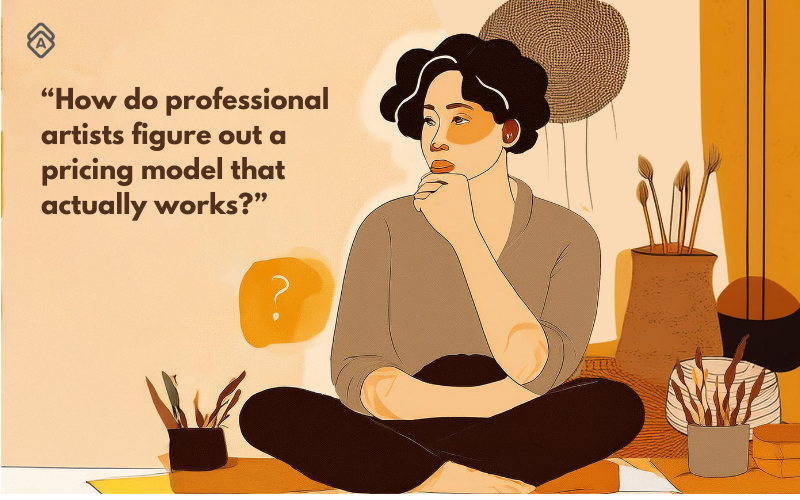 Welcome to Ask Artwork Archive, a space where we tackle the art career questions that never seem to have a straight answer.
Welcome to Ask Artwork Archive, a space where we tackle the art career questions that never seem to have a straight answer.
This week, we’re diving into a question from an artist who is stepping into the art market for the first time, ready to sell, but unsure of where to start with pricing. Without an exhibition history or past sales to reference, they're wondering: What should actually determine the price of my work?
Pricing artwork is one of those topics that can make even the most seasoned artists sweat.
There’s a lot of conflicting advice out there—should you price based on time and materials? Experience and reputation? The size of the piece? And what happens if you set your prices too high (or too low) and scare off buyers?
If you’ve ever stared at a finished piece, trying to figure out what number to attach to it, keep reading.
We’re breaking down the key factors that go into setting prices for your artwork with confidence—whether you’re a new arist or refining your strategy as your art career grows.
Let’s talk about how to price your artwork in a way that feels fair to you and attracts buyers.

Dear Artwork Archive,
I'm an artist very new to the art world. I’ve been creating art for some years, but only for myself and my mental health—never with the intent to sell. Recently, I’ve reached a point where I feel ready to share my work, and I even have opportunities to sell some pieces. My problem is…I have no idea how to price them!
I've heard conflicting advice. Some say price is based on materials and the time spent creating each piece. Others say those factors don’t matter at all. I've even heard that pricing should mainly reflect an artist's experience, exhibition history, and overall reputation. Coming from a background as an artisan, this is tough to wrap my head around because, with handcrafted goods, pricing is straightforward—I factor in my time, skill, and materials. But, pricing art seems to follow completely different rules.
So, my question is WHAT do I consider? To be honest, I've never exhibited or sold any work before, so my CV is pretty empty. How much should this impact my pricing? Should I base it on size, medium, or technical skill? Should I start low because I'm new, or would that undervalue my work in the long run? At the same time, I also don't want to scare off potential buyers with prices that are too high.
For context, I mostly work with fiber and mixed media, creating installations. My pieces range from small, detailed works (about 10x10 cm) to larger installations (up to about 180 cm). I’m a perfectionist who loves small details and can easily spend months on a work. I imagine pricing is tricky for artists working in all mediums—so how do professional artists figure out a pricing model that actually works?
I'd love insight into the key factors to consider and how I can approach pricing with confidence, especially as my career grows.
Sincerely,
Trying to Find the Right Number

Dear Right Number,
Ah, pricing—one of the most dreaded yet unavoidable parts of selling your work. You’re not alone in feeling stuck. Even established artists find themselves adjusting, second-guessing, and rethinking their numbers from time to time. It’s not an exact science, but there are ways to approach it with more confidence.
Let’s start with something important: your work has value—though, unlike a bowl or a lamp, that value isn’t always as tangible or easily defined. Especially when you’re just starting out, it can be hard to translate that value into a price. Your first step is to conduct market research on comparable artists in your area (and online). Who else is selling work like yours? What are their price points? Finding artists with similar experience levels, styles, and mediums will give you a sense of where your work fits. Check out artist websites, gallery listings, social media, and even Artwork Archive’s Discovery page to find artists whose careers align with where you are now. If you have artist friends, ask them about their pricing strategy.
About your “empty CV” you mentioned—it may matter to some galleries or collectors, but it won’t to everyone. Focus on building value in other ways: excellent documentation of your work (we can help with that!), a strong online presence, and pricing that reflects the quality of your pieces. Most buyers care more about connecting with the work itself than your exhibition history. That said, pricing isn’t just about presentation. And it’s not just about materials and time, either—though those factors do play a role. The bigger picture is more nuanced.
Here’s a solid starting artist pricing formula help you find a balance:
-
(Hourly Rate x Hours Worked) + Cost of Materials
Once you’ve added up the cost of materials, think about the time it took to bring your piece to life. 10 hours? 20? Set an hourly rate that feels fair for your skill level and experience. And be honest with yourself—just because something took you a month while you were still learning or experimenting doesn’t mean you should charge 160 hours for the full month. Pricing should reflect both effort and expertise. Buyers are paying for the expertise and final result, not for the process. (But that still doesn’t mean you should charge $5/hour—respect your work!)
For two-dimensional artworks, many artists use size-based pricing for consistency. Two of the most common methods are:
-
(Height × Width) × Price per square inch
-
Or (Height + Width) × Price per linear inch
To determine your price per inch, look at comparable artists' work and what they charge per square or linear inch. Be mindful that this should still reflect your skill level, medium, and overall demand for your work. A small, highly detailed painting may be worth more per inch than a larger, simpler piece. Some artists also establish tiered pricing—charging a higher per-inch rate for smaller works and a slightly lower rate for larger pieces, accounting for the fact that larger works don’t always cost proportionally more to produce.
Beyond size, materials matter in this equation too. If you’re working with high-end surfaces, rare pigments, or gold leaf, these factors should be reflected in the price per square inch. Likewise, consider the level of technical detail—if a piece requires months of fine detail work, it may be priced higher than a similar-sized piece with a looser, gestural approach. If you’re selling framed work, decide whether to include framing costs in the total price or offer it as an optional add-on. A professionally framed piece increases perceived value, but you’ll want to be sure the cost of framing doesn’t eat into your profits.
For sculpture and three-dimensional work (where size plays a bigger role) A common pricing method is:
-
(Height x Width x Depth) x Price per Cubic Inch or Foot
This formula provides a structured way to price work of varying sizes, but just like with two-dimensional art, the price per unit should reflect your experience, materials, and market demand in the price per cubic inch or foot. Material costs also add up quickly. If you’re working with expensive metals, ceramics, or rare woods, factor in not just the base material price but any special treatments, finishes, or casting fees.
Installation art adds another layer of complexity when pricing, since production, transportation, setup, and maintenance costs can vary widely. Many installation artists use a base price for the artwork itself and then outline additional charges for:
-
Fabrication costs – Materials, construction, and any third-party labor involved.
-
Transportation & shipping – Crating, handling, and delivery fees.
-
Installation & setup – Time and labor required for assembly.
-
Maintenance & long-term care – If the piece requires upkeep or has delicate components, consider offering a service agreement or guidelines for proper care.
Whatever method you choose, stay consistent. Pricing shouldn’t feel random—if someone questions your rates, you should be able to explain your logic without hesitation.
Let’s address another common mistake artists make when pricing their work: starting too low. It’s tempting, especially when you’re just starting to sell, to underprice your work out of fear that no one will buy. But pricing too low can actually work against you—it can make collectors hesitant and make it harder for you to raise prices later. If you’d feel disappointed letting a piece go for a certain price, that’s a sign you need to charge more. Think long-term, too. As you grow your career, gain collectors, and increase demand, your prices should also go up. This doesn’t mean you have to double them overnight, but small, gradual increases (10-20% per year) help keep your work valued appropriately.
One of the best ways to make informed pricing decisions about your artwork is to track your sales over time. Keep records of what’s selling and at what price so you can adjust based on real data, not just gut feeling. (This is where tools like Artwork Archive come in handy—having everything documented makes it so much easier to see patterns and tweak your pricing strategy as you grow.)
If you want a deeper dive into pricing strategies, we actually have a pre-recorded webinar: "Pricing Your Art With Confidence" that walks through this in more detail. It’s packed with insights from experts on how to price your work professionally—definitely worth a watch.
The bottom line? There’s no perfect formula, but the best pricing strategy is one that feels fair, sustainable, and allows room for growth. And no matter what you charge, someone will always say it’s too much—ignore them. Price with confidence, track your progress, and adjust as needed.
Your work has value. Make sure your pricing reflects that.
Cheering you on,
Artwork Archive
FREE Webinar: Price Your Art With Confidence
Pricing your art shouldn't feel like throwing darts in the dark. This must-watch webinar is packed with real-world insights from industry pros who've been there.
Featuring experts Shelli Beermann, Jodie King, and Kate Joiner, this panel breaks down the formulas, strategies, and biggest pricing mistakes to avoid.
Watch for free and take control of your pricing game
Have a sticky situation in your art business you're trying to navigate?
Whether you're wrestling with pricing questions, client communications, gallery relationships, or those delicate professional boundaries—we know running an art business comes with unique challenges.
Have a situation in your art career keeping you up at night? A professional puzzle you'd love help solving? Share your question through the form below. You could get the guidance you're seeking, and your experience might just help fellow artists navigate similar waters!
We're all in this creative journey together, and some of the best solutions come from our shared experiences.
We look forward to hearing from you!






